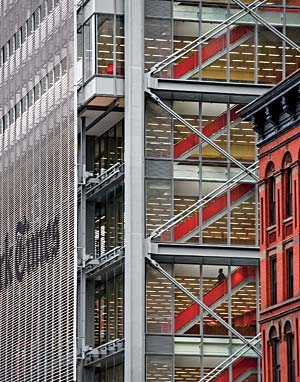Curtain-wall ingenuity eliminates the fear factor
Fear factor. That was the obstacle the New York Times and its New York–based architect, FXFOWLE, faced when it was time to bid the curtain wall for the media giant’s new headquarters in Midtown Manhattan. Design architect Renzo Piano conceived of a brise-soleil made of horizontal rods to project 18 inches from the curtain wall. Simple in concept, confounding in execution, when one imagines finding a strategy that would work for a 52-story tower. “While this approach has been achieved on a smaller scale in Europe, it had never been attempted at such a large scale in the U.S.,” confirms Daniel Kaplan, AIA, senior principal at FXFOWLE.

Contractors rely on precedent and predictability when preparing bids. Since the project’s curtain wall was innovative, it lacked both of these safety values. The architect and the client were correct to assume that curtain-wall contractors would approach the bidding with trepidation, which is to say that when fear is a factor, bids tend to soar; it is an understandable fact of risk management. As far as the client was concerned, however, keeping costs under control was paramount. Considering that a building’s envelope accounts for about 20 percent of the total construction cost, any precautionary padding of the estimates would result in unacceptable increases in overall construction costs.
The Times and its development partner, Forest City Ratner, decided on a pre-emptive strategy. They selected four qualified curtain-wall manufacturers, who were likely to bid on the project, and paid them to solve the problem and build a mock-up of a typical wall section, according to their solutions. “We gave them drawings of the basic design and the parameters—a 5-x-131¼2-foot [the height of one story] module with ceramic [aluminum silicate] rods [15¼8 inch diameter] placed at variable intervals,” explains Kaplan. “We gave each company performance criteria and asked them to engineer a solution in which many units could be fabricated in a timely manner for a certain price.”
This approach turned out to be inspired. Competition stimulates ingenuity, and all four companies suceeded. With the challenges under control and rationalized, the fear factor dissipated. When asked to bid the curtain wall based on their own investigations, every company delivered numbers that were below previous estimates and within the budget. In the end the client awarded the job to Portland, Oregon–based Benson Global, who also happens to be manufacturing the curtain wall for the Freedom Tower at Ground Zero.
The resulting curtain wall consists of several elements. There are the ceramic (aluminum silicate) rods. The rods as conceived, of course, were not standard building materials. Much effort and travel went into identifying a supplier. Eventually, the honor went to the maker of ceramic sewer pipes in Leipzig, Germany. The other major elements include a supporting structure for the screen and an insulated window unit. The architects and the contractors realized early on that assembling 170,000 rods on-site would be prohibitively time-consuming, expensive, and would make it impossible to guarantee rigorous quality control.
By using a method of unitized construction and building the curtain wall in its environmentally controlled Portland, Oregon, plant, Benson was able to combine the rod system and window assembly into a single unit, a strategy that was essential to feasiblity and consistency. Workers fabricated and assembled the different elements in accordance with the 5-by-131¼2-foot design module. Each unit uses aluminum “combs” to secure the rods. The combs are, in turn, supported by aluminum arms, which are connected to a steel screen-wall support structure. The insulated window unit is also based on the design module. Assembled separately, it consists of low-iron, double-glazed, spectrally selective vision glass with a high-performance low-e coating. In those areas where there are no rods, a subtle ceramic frit pattern was applied.
In an era in which value engineering often means eliminating the design while retaining the shell, the Times showed perserverence and ingenuity. By spending a few hundred thousand dollars up front to resolve the design issues, the client saved millions in the end.


Post a comment to this article
Report Abusive Comment